Palmolive
Continued onto: Colgate-Palmolive-Peet
In June, 1899, the B. J. Johnson Soap Company introduced a new green-coloured soap called Palmolive.
Palmolive Soap: “[I]s free from raw alkali. It is a solid pure cake that lathers freely and lasts well. It cleanses perfectly, and keeps the skin fine and soft. It has the beautiful natural color of the pure oils—and smells of its own fragrant wholesomeness.”
Sales were disappointing at first but, after an extensive advertising campaign, it went on to become so successful that the president of the company, Caleb Johnson, changed the company’s name to Palmolive in 1917. By then, the company had opened a subsidiary at 155-157 George Street, Toronto, Canada and Palmolive products were also available in Great Britain.

Above: Palmolive factory in Wisconsin.
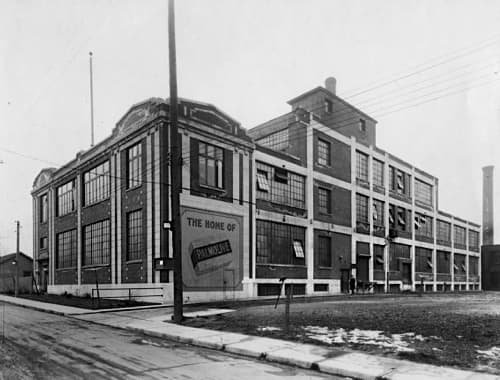
Above: Palmolive factory in Toronto, Canada, completed in 1917.
Palmolive line
Caleb Johnson capitalised on Palmolive’s popularity by introducing a number of flankers, starting with Palmolive Cream (1910), a type of cold cream, and Palmolive Shampoo (1912), a liquid soap. Both products were packaged in Palmolive green livery.
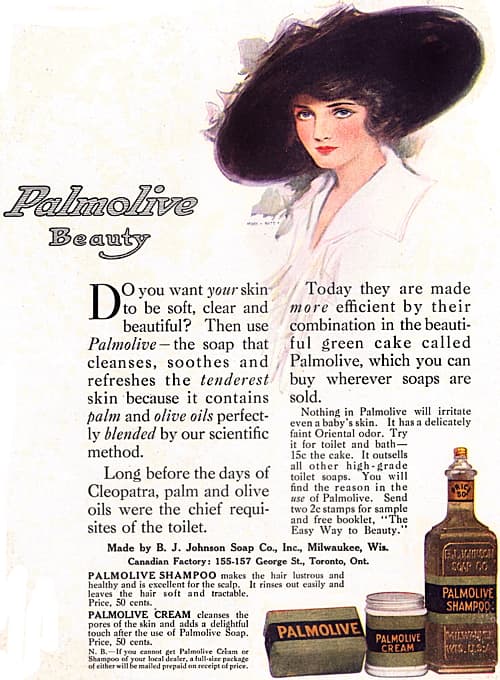
Above: 1913 Palmolive Soap, Cream and Shampoo.
Palmolive Cream: “[A] skillful blend of pure materials which make it the ideal skin food and massage cream. It absorbs quickly and the skin will take up an unlimited amount. Every particle is pure nutrition. It will absolutely not encourage the growth of hair.”
Palmolive Shampoo: “[C]ontains the same wonderful palm and olive oils that make Palmolive Soap so cleansing, softening and nourishing to the skin. It makes a delicious lather thick, creamy suds even in the hardest water.”
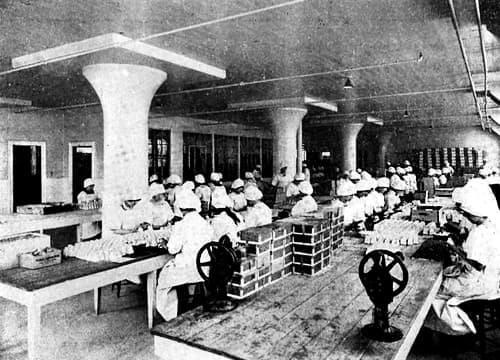
Above: 1925 Manufacturing Palmolive toiletries in Wisconsin.
Other Palmolive cosmetics followed including: Palmolive Face Powder, Palmolive Talcum, and Palmolive Vanishing Cream (1915); and Palmolive Rouge, and Palmolive Lip Rouge (1917). These new lines were packaged in more visually appealing containers than their predecessors which the company also updated while leaving the packaging for Palmolive soap unchanged.
Palmolive Vanishing Cream: “Prevents irritation; chapping; roughness; tan and sunburn; is the perfect foundation for powder. In all the indispensable daytime cream.”
Palmolive Powder: “[A]pplied day or evening, will never reveal its presence, save by the delicate charm of the complexion.” Shades: Flesh, Brunette, and White.
After the introduction of the Palmolive Vanishing Cream, Palmolive Cream was renamed as Palmolive Cold Cream which better reflected its original formulation. Both creams were now sold in tubes as well as jars.
See also: Cold Creams and Vanishing Creams
The company also added two Palmolive shaving products – Palmolive Shaving Stick and Palmolive Shaving Cream.
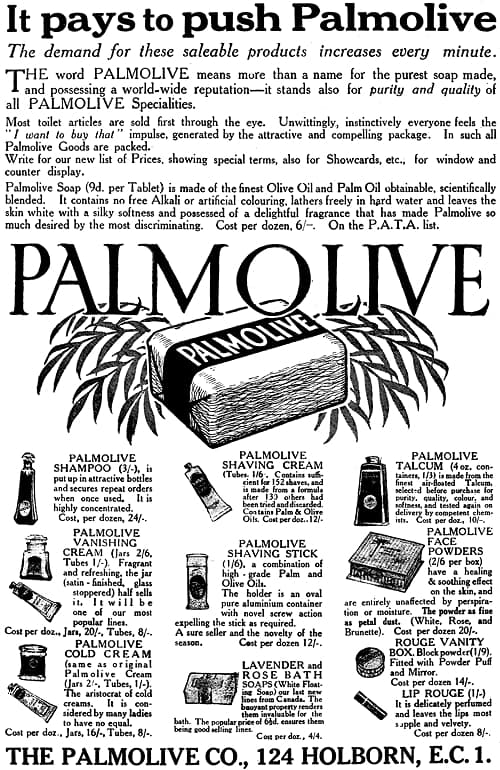
Above: 1919 Trade advertisement for Palmolive products in Britain. These were shipped from Canada after the factory was established there in 1917.
Australia
By happy accident, Palmolive’s first overseas factory was established in Australia. In 1918, a shipment of Palmolive Soap on its way to Russia had been left stranded in a Japanese port due to the Russian Revolution. After languishing in Japan for many years, and accumulating expensive storage costs, the consignment of soap found its way to Australia where it proved to be popular. This led to the establishment of the Palmolive Company (Australasia), Ltd. in 1921, and the construction of a factory in Balmain, Sydney in 1923, at a projected cost of £150,000.
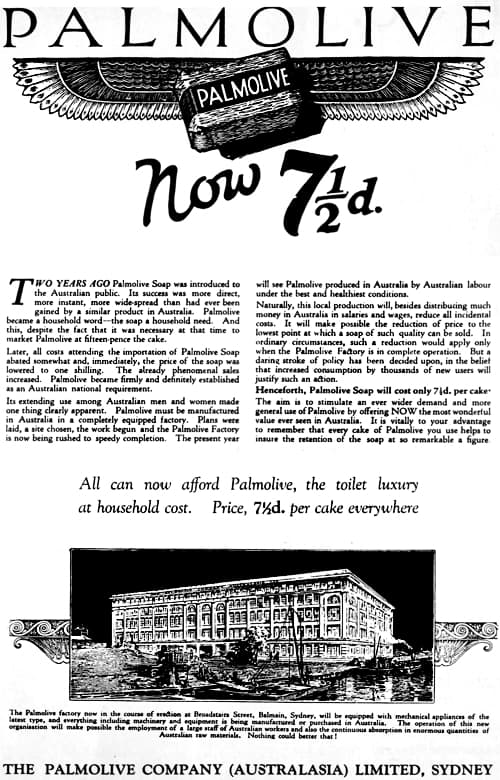
Above: 1923 Palmolive announcing a price drop in Palmolive soap pending the construction of an Australian factory.
The start of local production enabled Palmolive to drop the price of Palmolive soap, and make it more competitive with Unilever who also manufactured soap in Australia. It also meant that other Palmolive products could be made there.
Fanchon
Palmolive produced a number of other cosmetics apart from the Palmolive range including Palmo Face Powder, Cleopatra Divine Face Powder and the Fanchon range of cosmetics. Fanchon (1922) duplicated the Palmolive range in functionality but came with a different perfume and packaging and was given a French-sounding name. Included in the line was Fanchon Cold Cream, Vanishing Cream, Face Powder, Talcum Powder, Toilet Powder, Lipstick and Rouge.
Lournay
Most writers generally credit Palmolive with creating an American version of Lournay so that the company could import perfumes, cosmetics and other products from the French firm but there are problems with this story.
In 1920, Palmolive established the subsidiary Parfumerie Vernay, Inc. with Felix Lowy [1888-1937], a Palmolive company director, as its president. By August, 1920, the company name had been changed to Parfumerie Lournay and it had opened an office in Paris managed by J. Perez Henrique. I can find no reference to a French Lournay before this which suggests that the French company was an American creation.
The Paris office of Lounay was in temporary accomodation for a number of years moving from 5 Rue Nouvelle, Paris in 1920, to 3 Rue d’Ilsy in 1921, then 7 Rue d’Ilsy in 1922, before settling at 4 Rue de la Paix in 1924. The American arm was listed at 42 Fourth Street, Milwaukee, Wisconsin when it was founded but gave 366 Fifth Avenue, New York as its address when it began advertising its products in 1921. However, it moved to 509 Fifth Avenue in 1924 after Palmolive took out a 10-year lease on a floor in the building for executive offices and showrooms for its perfumery department.
Most of the Lournay cosmetics appear to have been manufactured in the United States with the company only claiming that Lournay lipsticks and rouge were made in France. No such claim can be definitively made for Lournay perfumes. Much has been made of the bottle for Vivante (1923) designed the firm of C. & J. Viard & R. of Montreuil-sur-Seine, France but the American company, Morana, Inc. was appointed their American representatives in 1922 so it is possible that the bottles were imported and filled with American-made perfume. I also note that Lournay British trademarks were lodged by Palmolive and that the company created a complete Lournay line in Australia in 1940 when any possible trade with France had been cut off due to the Second World War.
Lourney cosmetics included face powders, talcums, cold creams, vanishing creams, lemon creams, lipsticks and rouges, along with a range of compacts.
Créme de Toilette (Cold Cream): “[I]ndispensible for that fastidious cleanliness required by hygiene and beauty.”
Créme de Beauté (Vanishing Cream): “[P]rotects the most delicate skin against the effects of cold weather and makes an ideal base for face powder.”
Créme au Citron (Lemon Cream): “[A] smoothly blended bleaching face cream.”
Lournay Masque: “[W]orks out from the skin all the impurities of grime and powder clogged in the pores and leaves the skin firm and fine.”
Face Powder: “[A]bsolutely pure, adheres well, and imparts to the face a velvet-like softness without harming the skin in any way.” Shades: Blanche, Naturelle, Rachel, and Rosée, with Monte Carlo added by 1924.
Most of the Lournay range appears to have been discontinued in the United States after 1930, possibly a casualty of the 1928 merger that formed Colgate-Palmolive-Peet and/or the stock market crash of 1929.
In 1924, Palmolive created the Chandon Company, also based at 509 Fifth Avenue, New York to distribute Lournay as well as the handle the American distribution of the French perfumes of Lubin and Rosine. Like Lournay, Chandon does not appear to have outlasted the decade.
Management change
Caleb Johnson died childless in 1924 and his position as president was taken over by Charles Sumner Pearce. Pearce had joined the firm in 1903 and had risen though the ranks to become vice-president in 1920. In 1926, when Palmolive merged with the Peet Brothers Manufacturing Company – another soap producer founded by three brothers, Robert Peet [1843-1900], William Peet [1847-1934] and Jesse Peet [1849-1917] – to form Palmolive-Peet, Pearce continued on as president of the combined concern. This pattern was repeated when Palmolive-Peet merged with Colgate in 1928.
Also see: Colgate
Timeline
| 1864 | B. J. Johnson & Company founded. |
| 1872 | Peet Brothers & Company founded in Kansas City. |
| 1894 | B. J. Johnson & Company renamed the B. J. Johnson Soap Company. |
| 1899 | New Products: Palmolive Soap. |
| 1910 | New Products: Palmolive Cream. |
| 1912 | New Products: Palmolive Shampoo. |
| 1913 | Palmolive products available in Britain. |
| 1914 | B. J. Johnson Soap Company Toronto, Canada created. |
| 1915 | New Products: Palmolive Powder; Palmolive Talcum; and Palmolive Vanishing Cream. |
| 1916 | Factory opened in Berkeley, California. |
| 1917 | B. J. Johnson Soap Company becomes the Palmolive Company. Canadian factory opened. New Products: Palmolive Rouge; and Palmolive Lip Rouge. |
| 1920 | Parfumerie Vernay, Inc, founded; changed to Parfumerie Lournay, Inc. |
| 1921 | Palmolive Company (Australasia) Ltd. founded. |
| 1922 | Palmolive Company (of England) Ltd. founded. New Products: Fanchon range. |
| 1923 | Société Anomyme Palmolive established in Paris. Factory opened in Balmain, Sydney. |
| 1924 | The Chandon Company created. |
| 1926 | Palmolive merges with Peet Brothers to become Palmolive-Peet. |
| 1928 | Colgate merges with Palmolive-Peet to form Colgate-Palmolive-Peet. |
Continued onto: Colgate-Palmolive-Peet
First Posted: 26th January 2021
Last Update: 7th February 2021
Sources
The American Perfumer & Essential Oil Review. (1906-1955). New York: Robbins Perfumer Co. [etc.].
Bruce, W. G. (Ed.). (1922). History of Milwaukee: City and county (Vol. II). Chicago, Il: The S. J. Clarke Publishing Company.
Colgate-Palmolive-Peet. (1936). Fortune, XIII(4). 120-125, 138, 142-142, 148.
The Palmolive company. (c.1925) A day in the Palmolive factory. Milwaukee: Author.
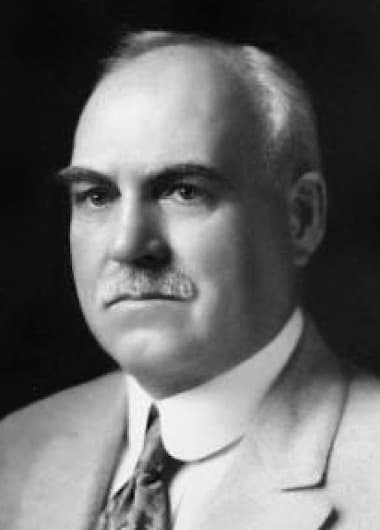
Caleb Elliott Johnson [1857-1924], the son of the company founder, Burdette Jay Johnson [1826-1902].
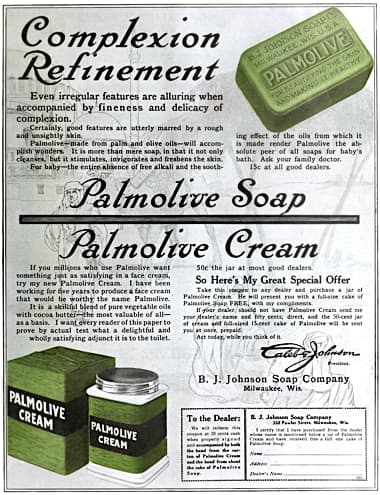
1910 Palmolive Soap and Palmolive Cream.

1915 Palmolive Powder, Palmolive Talcum, and Palmolive Vanishing Cream.
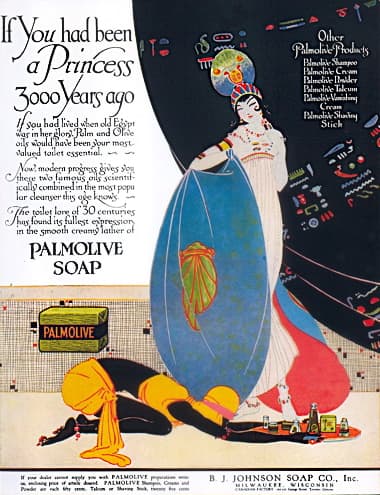
1915 Palmolive products.
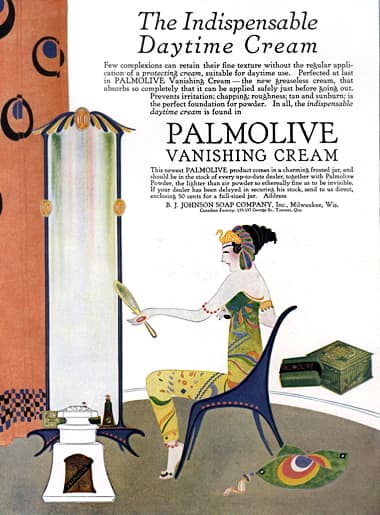
1916 Palmolive Vanishing Cream.

1916 Palmolive Powder.
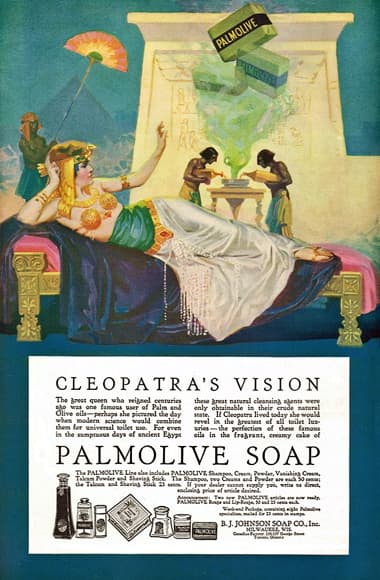
1917 Palmolive Shampoo, Talcum, Shaving Stick, Face Powder, Vanishing Cream, Cold Cream, and Soap.

1918 Palmolive Shampoo in a new bottle.
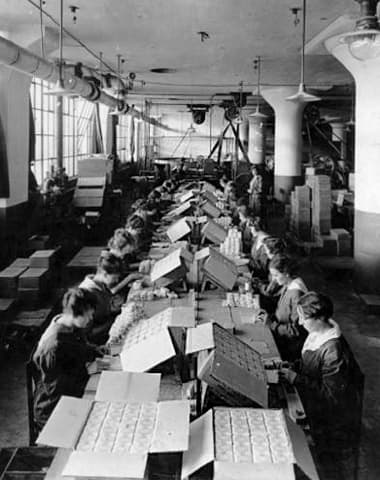
1919 Packing Palmolive Soap into cartons in the Canadian factory.
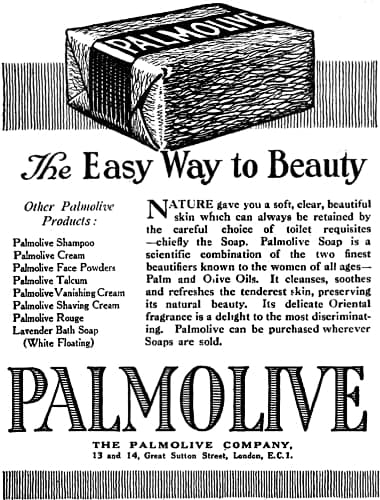
1920 Palmolive products (Britain).
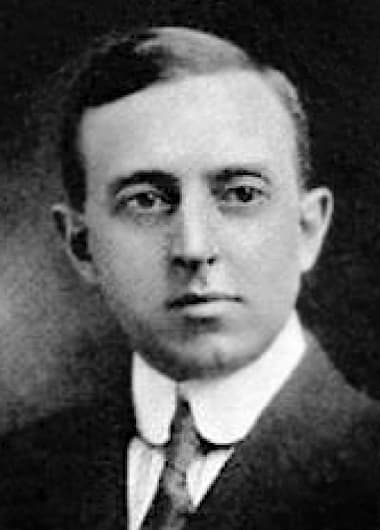
Charles Sumner Pearce [1877-1965].
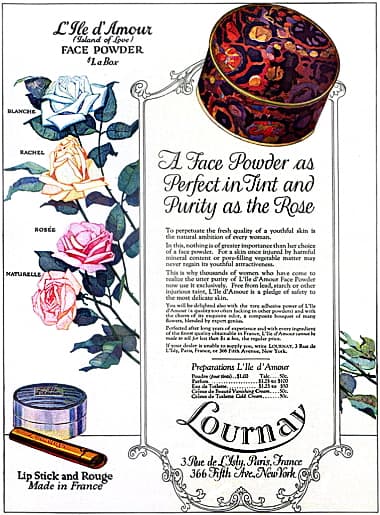
1921 Lournay Face Powder, Rouge and Lipstick.
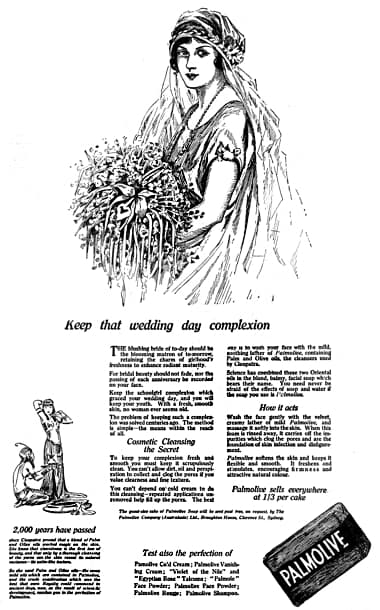
1922 Palmolive (Australia). Available products now include Palmolive Cold Cream, Palmolive Vanishing Cream, Violet of the Nile and Egyptian Rose Talcums, Palmole Face Powder, Palmolive Face Powder, Palmolive Rouge, and Palmolive Shampoo.

1922 Lournay Créme de Citron, and Face Powder.
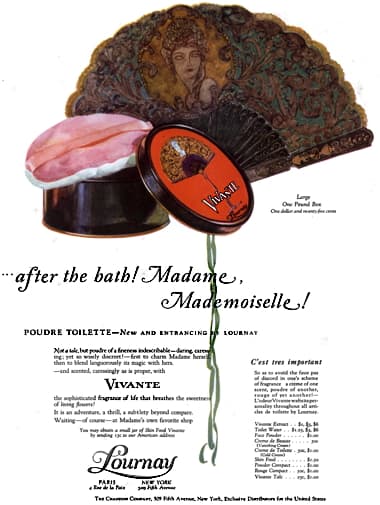
1924 Lournay Vivante distributed by Chandon.
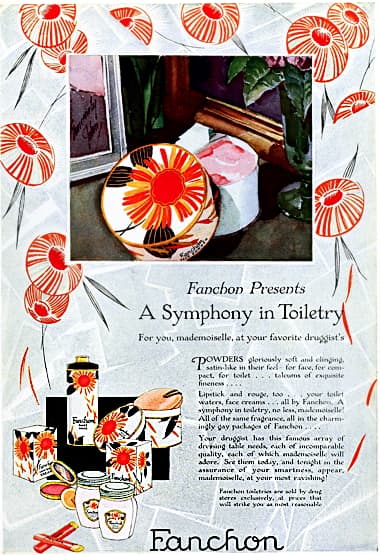
1928 Fanchon.
